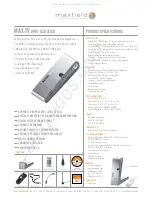
Service Modes, Error Codes, and Fault Finding
EN 29
EL1.1U
5.
5.7
Protections
5.7.1
Software Protections
Most of the protections and errors use either the stand-by
microprocessor or the VIPER controller as detection device.
Since in these cases, checking of observers, polling of ADCs,
filtering of input values are all heavily software based, these
protections are referred to as software protections.
There are several types of software related protections, solving
a variety of fault conditions:
•
Protections related to supplies:
check of the 12V, +5V,
+8V6, +1.2V, +2.5V and +3.3V.
•
Protections related to breakdown of the safety check
mechanism.
E.g. since a lot of protection detections are
done by means of the VIPER, failing of the VIPER
communication will have to initiate a protection mode since
safety cannot be guaranteed anymore.
Remark on the Supply Errors
The detection of a supply dip or supply loss during the normal
playing of the set does not lead to a protection, but to a cold
reboot of the set.
Protections during Start-up
During TV start-up, some voltages and IC observers are
actively monitored to be able to optimize the start-up speed,
and to assure good operation of all components. If these
monitors do not respond in a defined way, this indicates a
malfunction of the system and leads to a protection. As the
observers are only used during start-up, they are described in
the start-up flow in detail (see paragraph “Stepwise Start-up").
5.7.2
Hardware Protections
There is one hardware protection in this chassis: “Audio DC
Protection”. This protection occurs when there is a DC voltage
on the speakers. In that case the main supply is switched "off",
but the stand-by supply is still working.
For the Samsung V4 PDP displays, the 8V6 supply is switched
"off" and the LED on the display’s Main Supply blinks eleven
times, which means there is an overvoltage protection. The
front LED of the TV will blink error 7 (8V6 error).
In case of LCD supplies, the 12V supply will drop. This will be
detected by the stand-by processor, which will start blinking the
12 V error (error 12).
Repair Tip
•
It is also possible that you have an audio DC protection
because of an interruption in one or both speakers (the DC
voltage that is still on the circuit cannot disappear through
the speakers).
5.8
Fault Finding and Repair Tips
Read also paragraph "Error Codes" - "Extra Info".
5.8.1
Exit “Factory Mode”
When an "F" is displayed in the screen's right corner, this
means that the set is in "Factory" mode, and it normally
happens after a new SSB has been mounted.
To exit this mode, push the "VOLUME minus" button on the
TV's keyboard control for 5 seconds and restart the set
5.8.2
MPIF
Important things to make the MPIF work:
•
Supply.
•
Clock signal from the AVIP.
•
I
2
C from the VIPER.
5.8.3
AVIP
Important things to make the AVIP work:
•
Supplies.
•
Clock signal from the VIPER.
•
I
2
C from the VIPER (error 29 and 31).
5.8.4
DC/DC Converter
Introduction
•
The best way to find a failure in the DC/DC converters is to
check their starting-up sequence at power "on" via the
Mains/AC Power cord, presuming that the Stand-by
Processor is operational.
•
If the input voltage of the DC/DC converters is around 12 V
(measured on the decoupling capacitors 2U17/2U25/
2U45) and the ENABLE signals are "low" (active), then the
output voltages should have their normal values.
•
First, the Stand-by Processor activates the +1V2 supply
(via ENABLE-1V2).
•
Then, after this voltage becomes present and is detected
OK (about 100 ms), the other two voltages (+2V5 and
+3V3) will be activated (via ENABLE-3V3).
•
The current consumption of controller IC 7U00 is around 20
mA (that means around 200 mV drop voltage across
resistor 3U22).
•
The current capability of DC/DC converters is quite high
(short-circuit current is 7 to 10 A), therefore if there is a
linear integrated stabilizer that, for example delivers 1.8V
from +3V3 with its output overloaded, the +3V3 stays
usually at its normal value even though the consumption
from +3V3 increases significantly.
•
The +2V5 supply voltage is obtained via a linear stabilizer
made with discrete components that can deliver a lot of
current. Therefore, in case +2V5 (or +2V5D) is short-
circuited to GND, the +3V3 will not have the normal value
but much less.
•
The supply v12VSW is protected for over-currents
by fuse 1U04.
Fault Finding
•
Symptom:
+1V2, +2V5, and +3V3 not present (even for a
short while ~10ms).
1.
Check 12V availability (fuse 1U01, resistor 3U22,
power MOS-FETs) and enable signal ENABLE-1V2
(active low).
2.
Check the voltage on pin 9 (1.5 V).
3.
Check for +1V2 output voltage short-circuit to GND that
can generate pulsed over-currents 7-10 A through coil
5U03.
4.
Check the over-current detection circuit (2U12 or 3U97
interrupted).
















































